WEEKLY WATCH
2011-10-14
WEEKLY WATCH
OPINION
Per-Capita Income
The Chinese Academy of Social Sciences issued a blue paper on industry, the Annual Report on Industrial Competitiveness of China, on December 12. According to World Bank’s 2011 standard, China is already an upper middle-income country. The World Bank puts countries whose per-capita annual income between $3,856 and $11,905 as upper middle-income countries. According to the National Bureau of Statistics, China’s percapita income for 2010 stood at $ 4,277.
Statistically speaking, it’s true that China is an upper middle-income country. However, we must not forget one thing. The Gini Coefficient, which is a measurement of the gap between the rich and the poor in a country, warns that when the number surpasses 0.4, the gap is already very large and social stability is in danger. The Gini Coefficient in China is now 0.53, and is still growing.
That’s why although China is already labeled as an upper middle-income country, we can’t neglect the 150 million people who are still living in extreme poverty and the 230 million migrant workers who have no access to basic social security and welfare. These statistics tell that the country’s overall wealth does not necessarily represent ordinary families’ living conditions. Besides, although China’s annual per-capita GDP has surpassed $4,000, the per-capita disposable income is far from $2,000. Half of the country’s GDP does not benefit the ordinary people.
A country’s real national strength depends on the public’s overall living conditions, not the small group at the top.
Yanzhao Evening News
Pass Rate of Exports
According to the white paper China’s Foreign Trade, issued by the State Council, the quality of China’s exports is improving on the whole. In 2010, the pass rate of exports to the United States reached 99.5 percent while those to the EU hit 99.8 percent and to Japan reached 99.7 percent. The Japanese food authorities spot-checked 20 percent of food imported from China, and the pass rate was 99.74 percent.
The high pass rate of exported food composes a striking contrast to dangerous food in China. Some food even can’t reach the bottom line of edibility. China’s dairy products, for example, are deteriorating.
Many countries have strict criteria for food safety, particularly for imported food. If you fail to meet their quality standards, your exports are not allowed in. Once a certain kind of food is discovered deficient in quality, a ban will fall on the import of this food, and even relevant products will be banned. As a result, Chinese food producers have to work carefully, while food inspection authorities also begin to strengthen supervision.
The high pass rate of exported food proves that Chinese businesses are able to produce safe food and food watchdogs are able to ensure food safety. The quality of food products in the domestic market should be as good as those exported. The key is a stricter food safety criteria and strong determination to safeguard the public’s health.
Changjiang Daily
College Subject Design
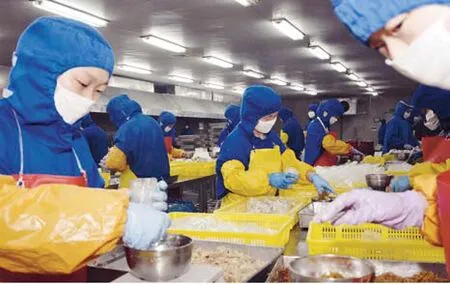
HIGH QUALITY: A food company in east China’s Shandong Province is preparing products bound for Japan
The Education Ministry of China recently published the result of a study on college student employment. According to the study colleges are not vocational or technical schools, and thus employment rate should not be used as the only guideline for colleges’subject design.
The result of the study reminded people of a statement of the Ministry of Education, which demands colleges reduce recruitment of subjects that see employment rate lower than 60 percent for two years consecutively. These subjects might finally be canceled.
It’s understandable for the ministry to suggest the direct link between employment rate and college subject design. But, deciding a subject’s fate by solely referring to the employment rate seems somewhat unreasonable. Actually, graduates from prestigious universities can always find satisfactory jobs, no matter what major they are in, while those from common universities always have difficulty finding a job.
More importantly, if low employment rate subjects are all cut, we’ll see the disappearance of humanities and basic science subjects in key universities, making it impossible for some key scientific research to go on.
Employment rate is very important, but an overemphasis on it will do harm to a college’s sound development, and is not in the interest of students.
Guangming Daily
Students’ Sleep
Growing evidence shows that primary and middle school students in China are sleeping less and less in recent years, with 80 percent of them lacking sleep.
According to the Guide of Health Education in Primary and Middle Schools issued by the Education Ministry, primary school students should sleep 10 hours a day, junior and senior middle school students should sleep at least 9 and 8 hours a day. However, the China Youth & Children Research Center’s survey in 2010 showed that students’ actual sleep time is much less.
A forum on children’s healthy and happy growth was held in Beijing on December 11. Education departments organized the forum in order to find out why students are so heavily burdened and come up with ways to deal with the situation.
The importance of relieving children from heavy academic burdens is obvious, but despite repeated calls from education departments to reduce pressure on students, schools will never give in when it comes to how many students can enter higher schools.
Thus, the key is not numerous orders to alleviate burdens on students, but a new education performance measurement mechanism to tangibly liberate children from academic pressure and enjoy more sleep.
Xi’an Evening News
SOCIETY
Regulating School Buses
The Legislative Affairs Office of the State Council, China’s cabinet, issued a draft regulation on school bus safety management on December 11 and asked for public feedback.
The draft stipulates that local governments above the county level should take“overall responsibility” for school bus safety.
The government will establish and regularly update a system of mandatory technical standards for the quality of vehicles used as school buses.
China issued a set of technical standards for school buses for primary school students last year, and the drafting of another standard for buses used in kindergartners is also underway.
According to the draft, the government will adopt a license system for school bus operation.
Measuring Emissions
China plans to develop its own new comprehensive system for monitoring and accurately calculating the country’s greenhouse gas (GHG) emissions, said a leading Chinese scientist.
Ding Zhongli, Vice President of the Chinese Academy of Sciences (CAS), said that the new system would help the country keep track of exactly how much GHG it emits, knowledge that will serve as the basis for China’s carbon emission reduction efforts.
Researchers will compile GHG emission lists for the quantitative evaluation of carbon dioxide emissions generated through both natural process and human activities, as part of an ongoing research program led by the CAS.
The list will cover major human activities that cause emissions such as energy generation, cement production, land use and livestock farming, said Ding.
Submarine Success
Sixteen submarine hydrothermal deposits were discovered during China’s largest global ocean expedition, researchers said. The deposits of metals and minerals occur in the deep ocean when water is heated by magma through fissures in the earths crust.
The 369-day expedition, the country’s 22nd, was conducted by the expedition vessel,Ocean No.1, which traversed the Indian, Atlantic, and Pacific oceans between December 8, 2010 and December 11.
Tao Chunhui, chief scientist of the expedition team, said that five of the 16 submarine hydrothermal deposits were discovered in the south of the Atlantic Ocean, and the other 11 in the east Pacific Ocean.
China has discovered 33 submarine hydrothermal deposits in the three oceans since the 19th expedition in 2007. These discoveries account for one in 10 of the hydrothermal deposits discovered during the last three decades.
Record Maker
A medicinal botanic garden in southwest China’s Guangxi Zhuang Autonomous Region has been confirmed by Guinness World Records to contain the most varieties of medicinal plants and the largest cultivated area of medicinal plants in the world.
The garden covers 202 hectares and is home to more than 6,000 species of living medicinal plants (including more than 100 endangered varieties and over 30 new varieties), over 3,200 kinds of medicinal plant seeds and 100,000 images of medicinal plants.
Guangxi’s health authorities built the garden in 1959, aiming to cultivate, collect and save medicinal plants and also conduct research.
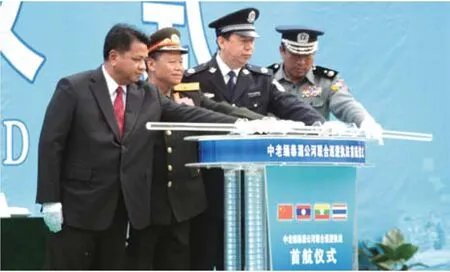
JOINT OPERATION Police officers from China, Laos, Myanmar and Thailand take part in the launching ceremony of the joint patrol along the Mekong River in Guanlei Port in Yunnan Province on December 10. The joint patrol restores shipping services on the Mekong River, which were suspended since attacks on Chinese ships in October
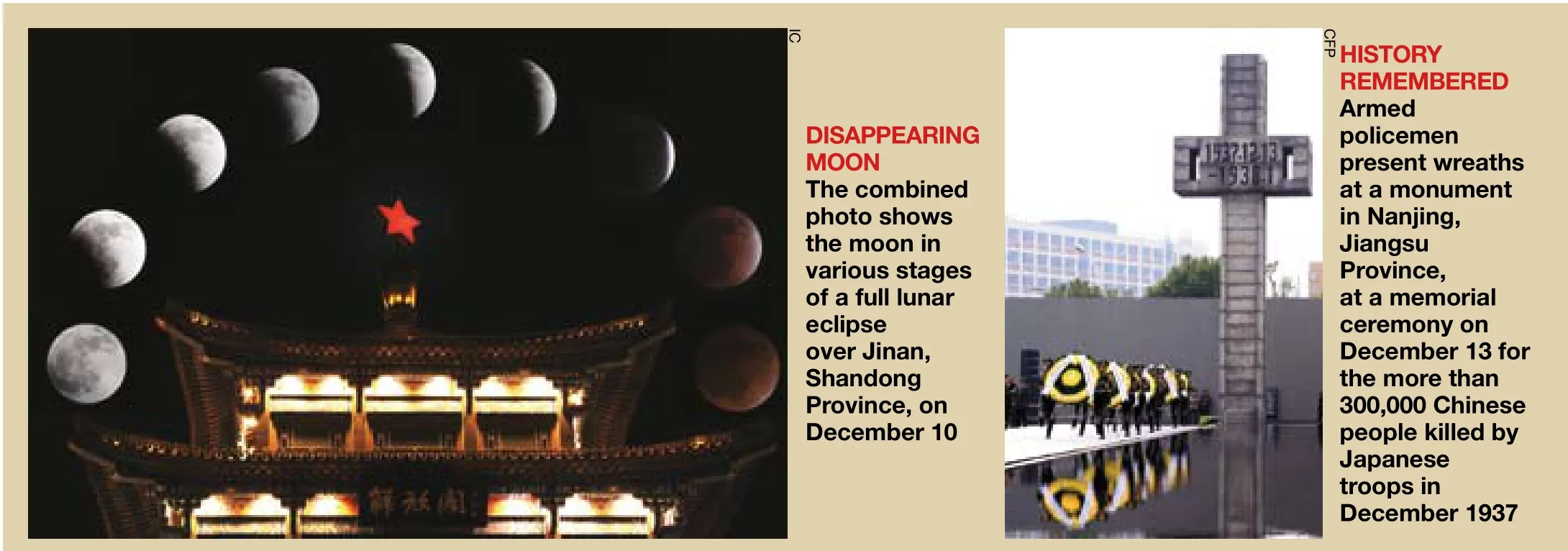
ECONOMY
FDI Down
China’s foreign direct investment (FDI) dropped 9.76 percent year on year to $8.76 billion in November, said the Ministry of Commerce (MOFCOM).
The number of foreign-invested companies approved by the Chinese Government in November also dropped 12.91 percent from a year earlier to 2,718, according to the MOFCOM.
The weakened FDI in November was largely affected by gloomy economic growth in the United States and debt woes in the EU, said Shen Danyang, a MOFCOM spokesman.
The November figure brought the total FDI in the first 11 months to $103.77 billion, up 13.15 percent year on year.
During the same period, the government approved the establishment of 25,086 foreign-invested companies, up 3.23 percent year on year.
Duties on U.S. Vehicles
China decided to levy anti-dumping and anti-subsidy duties on sedans and sport-utility vehicles with engines of 2.5 liters and above imported from the United States, after an investigation showed evidence of dumping.
Effective December 15, importers of related vehicles from the United States are required to set aside deposits with Chinese customs ranging from 2 percent to 12.9 percent according to the level of dumping and the subsidies U.S. carmakers received from their government.
U.S. carmakers, including General Motors and Chrysler Group, have received government subsidies and dumped their vehicles into the Chinese market, which has harmed China’s auto industry, the Ministry of Commerce said in a statement.
The duties will expire on December 14, 2013.

NEW RECORD A cargo ship passes through the Gezhouba lock on the Yangtze River on December 12. That day, the annual freight volume of the lock reached 100 million tons, nearly 30 times that in 1981 when it was first opened
Offshore Drilling
The China National Offshore Oil Corp. (CNOOC), the country’s biggest offshore oil and gas company, will start drilling the first well in the Block F offshore in Cambodia’s Preah Sihanouk Province later this month, said Li Fanrong, CEO of CNOOC on December 13 in Phnom Penh.
The first well drilling is expected to cost $20 million.
Sok An, Cambodian Deputy Prime Minister and Minister in charge of the Office of the Council of Ministers, said it was a very good sign for Cambodia’s oil and gas sector and added that Cambodia fully supported CNOOC for the drilling.
He also asked the CNOOC to help train Cambodian petroleum officials to keep up with new techniques in oil and gas industry.
Steel Provider
Anshan Iron and Steel Group Corp. (Anshan Steel) said on December 14 that it has clinched a strategic partnership with the A.P. Moller-Maersk Group, the world’s largest container shipping operator.
The two sides signed a strategic cooperation agreement in Shanghai in which Anshan Steel promised to supply high-quality products for Maersk’s ships.
Anshan Steel, based in northeast China’s Liaoning Province, is China’s largest supplier of container board steel.
Maersk Line, the container division of the Denmark-based company, has a fleet of more than 500 vessels.
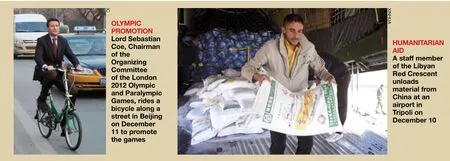
1. GERMANY
CEO of German rail giant Deutsche Bahn Ruediger Grube (left) gives the all-clear signal as the Moscow-to-Paris overnight express train makes its way out of Berlin on December 13
2. RUSSIA
Russian metals tycoon and U.S. basketball team owner Mikhail Prokhorov announces his intention to challenge Prime Minister Vladimir Putin in next year’s presidential elections in Moscow on December 12
3. THE PHILIPPINES
A Philippine traffic enforcer wears a Santa Claus costume while directing traffic along a major road in Manila on December 6
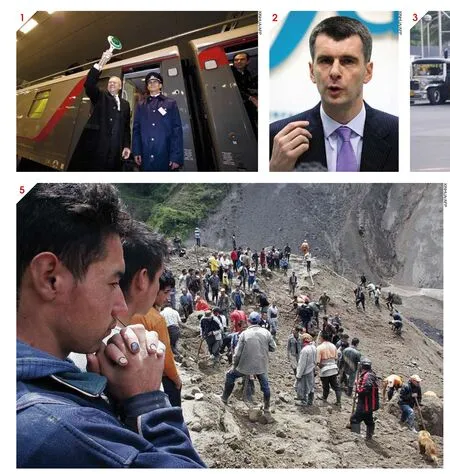
4. INDIA
Rescue workers evacuate a hospital staff member as a fire engulfs the hospital in the eastern Indian city of Kolkata on December 9. At least 89 people were killed in the fire
5. COLOMBIA
Relatives of people missing after a landslide wait in La Cruz, Colombia on December 13. The landslide in a mountainous southwestern region has killed a child and left about 15 people missing
6. MIDDLE EAST
Palestinian (right) and Hamas flags flutter as thousands of supporters of the Islamist movement Hamas gather in Gaza City to celebrate the 24th anniversary of its foundation on December 14

